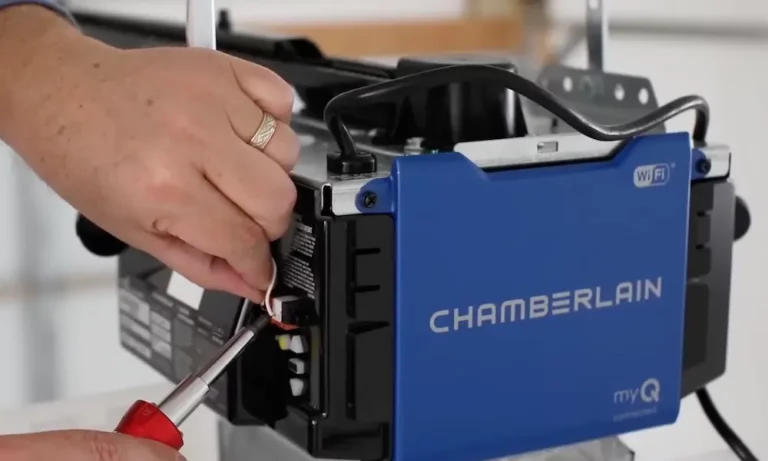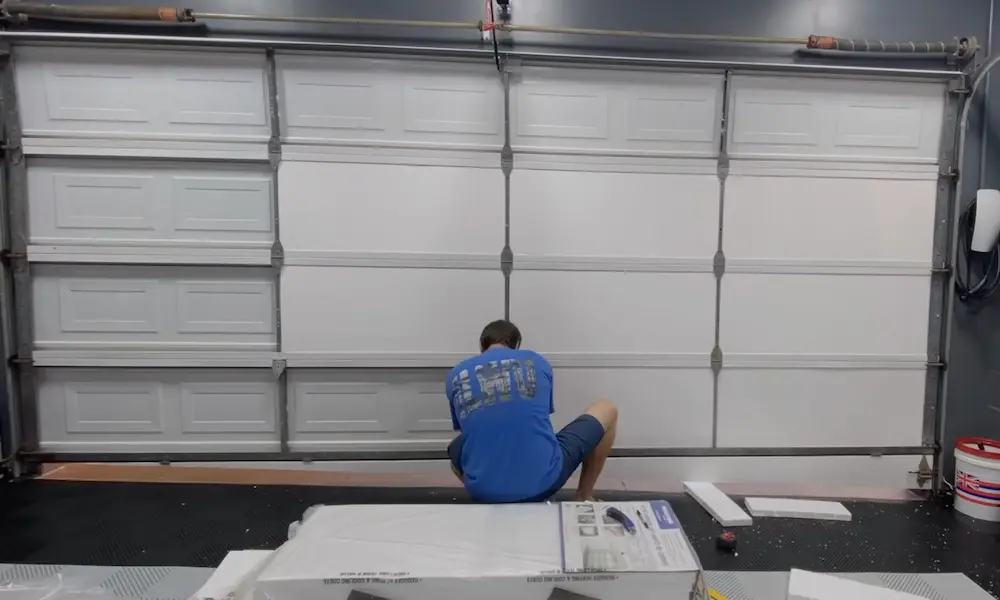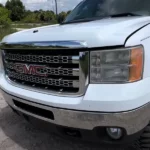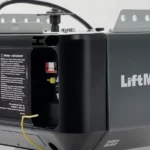Is your Chamberlain garage door opener giving you trouble? You’re not alone. That trusty device that reliably opens and closes your garage door can sometimes stop working without warning. But before you call in a professional, there’s good news – many common Chamberlain opener problems can be fixed with simple DIY troubleshooting.
In this guide, I’ll walk you through the most common reasons why your Chamberlain garage door opener might not be working and provide step-by-step solutions to get it back up and running.
Check the Power Source First
When your Chamberlain garage door opener suddenly stops working, always start with the most obvious culprit – the power supply. Here’s what to check:
- Is it plugged in? Make sure the opener is properly connected to a working outlet. It sounds obvious, but power cords can get accidentally disconnected.
- Test the outlet. Plug a lamp or phone charger into the same outlet. If that doesn’t work, you might have a blown fuse or tripped circuit breaker.
- Examine the power cord. Look for any visible damage like fraying, cuts, or pinched areas that might interrupt electricity flow.
- Check your circuit breaker. Recent power outages or electrical storms can trip breakers. Flip it back if needed.
- Wait for reset. If there was a power surge, your opener might need a few minutes to reset its internal systems before working again.
If your opener still shows no signs of life after confirming it has power, it’s time to dig deeper into other potential issues.
Safety Sensors Alignment Problems
If your garage door opens normally but refuses to close (or starts closing but reverses), the safety sensors are the likely culprit. These small devices protect people and objects from being crushed by detecting obstacles in the door’s path.
Here’s how to check and fix sensor issues:
- Locate the sensors. You’ll find two small units mounted on either side of your garage door opening, about 6 inches off the floor.
- Check for obstructions. Even small items like leaves or spider webs can block the invisible beam between sensors.
- Look at the indicator lights. Most Chamberlain sensors have LED lights that should be lit steadily when properly aligned. If they’re blinking or off, that indicates a problem.
- Clean the lenses. Use a soft, lint-free cloth to wipe away dust or dirt that might be blocking the beam.
- Realign the sensors. Make sure both sensors are pointing directly at each other. Even slight misalignment can cause problems. Loosen the mounting brackets if needed to adjust their position.
- Check the wiring. Inspect the wires running from each sensor to the opener for damage or loose connections.
Proper sensor alignment is crucial for safety and functionality. Don’t bypass these sensors – they’re there to prevent accidents and injuries.
Remote Control Not Working
Is your wall control functioning but your remote doesn’t work? Here’s how to troubleshoot remote control issues:
- Replace the battery. This is the most common and easiest fix. Use a fresh battery of the correct type.
- Check operating distance. Stand closer to the garage when testing. Remote range can be affected by:
- Battery strength
- Weather conditions
- Radio interference from other devices
- Physical obstructions like metal objects
- Reprogram the remote. Your remote might need to be synced with the opener:
- Locate the “Learn” button on your opener (usually yellow)
- Press and release the Learn button
- Within 30 seconds, press the remote button you want to program
- The opener’s lights should blink or you’ll hear a click to confirm successful programming
- Try a factory reset. If nothing else works:
- Press and hold the Learn button for 6-8 seconds until the LED light goes out
- Press it again until the LED goes out a second time
- For myQ models, a third press might be needed, followed by three beeps
- Reprogram all remotes after the reset
If multiple remotes aren’t working, the issue is likely with the opener’s receiver rather than the remotes themselves.
Understanding Error Codes and Light Flashes
Chamberlain openers communicate problems through flashing lights or error codes. Learning to interpret these signals can quickly point you to the specific issue:
| Flash Count | Likely Problem | Solution |
|---|---|---|
| 1 flash | Remote control issue | Reprogram remote |
| 2 flashes | Door movement interrupted | Remove obstructions, check door balance |
| 3 flashes | Safety sensor problem | Check alignment and wiring |
| 4 flashes | Sensors not staying on consistently | Realign sensors, check connections |
| 5 flashes | Motor or RPM sensor issue | Motor may be overheating or damaged |
| 6 flashes | Motor circuit failure | Check for stuck wall buttons or remote buttons |
| 9 flashes | Circuit board failure | May need professional repair or replacement |
For modern Chamberlain models with displays, specific error codes may appear. Consult your model’s manual for precise meaning and solutions.
Logic Board and Motor Issues
The logic board is essentially your opener’s brain, and when it fails, the whole system can act erratically. Here’s how to troubleshoot more serious electrical problems:
- Reset the logic board. Unplug the opener for 15 minutes to allow a full discharge, then restore power.
- Inspect for physical damage. Open the opener housing and look for:
- Burned or charred components
- Bulging capacitors
- Water damage or corrosion
- Loose connections
- Check for signs of motor problems:
- Unusual noises during operation
- Excessive heat from the motor housing
- Intermittent operation
- Complete failure to move the door
- Test the motor capacitor. A failing capacitor can prevent the motor from starting properly. Look for swelling or leakage.
While you can check for obvious signs of damage, replacing a logic board or motor typically requires specific technical knowledge. If you suspect these components have failed, it might be time to consult a professional.
Mechanical Issues with the Door Itself
Sometimes what appears to be an opener problem is actually an issue with the garage door mechanism. Check these mechanical elements:
- Door balance test. Disconnect the opener (pull the emergency release cord) and manually lift the door halfway. It should stay in place without rising or falling significantly. If it doesn’t, the springs need adjustment.
- Look for binding or sticking. With the door disconnected, open and close it manually to feel for any spots where it binds or requires extra force.
- Inspect rollers and tracks. Look for:
- Damaged or worn rollers
- Debris in the tracks
- Bent or misaligned tracks
- Missing bolts or fasteners
- Check the torsion springs. Broken or worn springs make the door too heavy for the opener to lift. Never attempt to repair or adjust torsion springs yourself – they’re under extreme tension and can cause serious injury.
- Examine the trolley connection. Make sure the trolley (the part that moves along the rail and connects to the door) isn’t damaged or disconnected.
If your door is difficult to move manually, no garage door opener will function properly until the mechanical issues are resolved.
Performing a Complete System Reset
When troubleshooting doesn’t pinpoint a specific problem, a full system reset can often resolve software glitches and communication errors:
- Ensure safety first. Close the garage door completely before beginning.
- Power down the system. Unplug the opener from the electrical outlet.
- Wait for complete discharge. Leave it unplugged for at least 15 minutes to ensure all capacitors discharge fully.
- Reset the memory. After restoring power:
- Find the Learn button on your opener
- Press and hold it for about 6-8 seconds until the indicator light turns off
- Press and hold again until the light goes off a second time
- For myQ models, press a third time until you hear three beeps
- Reprogram all devices. After a hard reset, you’ll need to reprogram:
- All remote controls
- Keyless entry pads
- myQ app connections
- Any smart home integrations
A system reset erases all programmed settings, returning your opener to its factory default state. This can often clear mysterious electronic glitches that don’t have obvious causes.
myQ Smart Functionality Problems
If you’re using Chamberlain’s myQ technology for smartphone control and you’re experiencing problems with the app or connectivity:
- Check your Wi-Fi connection. Ensure your garage door opener is within range of a strong Wi-Fi signal.
- Verify the myQ gateway. If using a separate gateway device, confirm it’s powered on and connected to your network.
- Restart the app. Close and reopen the myQ app on your smartphone.
- Update software. Make sure both your opener’s firmware and the myQ app are updated to the latest versions.
- Re-link your account. Sometimes logging out and back into the myQ app can resolve connection issues.
- Reset the myQ settings. You might need to reconnect your opener to the myQ system by following the setup process again.
Remember that even if smart functionality isn’t working, your opener should still respond to the wall control and remote controls unless there’s a separate mechanical or electrical issue.
Essential Preventive Maintenance
Preventing problems is easier than fixing them. Here’s a maintenance schedule to keep your Chamberlain opener working reliably:
- Monthly checks:
- Test safety reversal system with a 2×4 laid flat under the door
- Verify sensor operation by breaking the beam during closing
- Inspect door balance by disconnecting opener and moving door manually
- Every 3-6 months:
- Lubricate moving parts (rollers, hinges, springs) with silicone-based lubricant
- Tighten any loose hardware on the door and track
- Check chain/belt tension and adjust if necessary
- Clean safety sensor lenses
- Annual maintenance:
- Inspect and tighten all mounting brackets and hardware
- Check all wiring connections for secure attachment
- Test backup battery if your model has one
- Clean and lubricate the opener’s chain or belt drive
Regular maintenance not only prevents breakdowns but also extends the life of your opener and ensures it operates safely.
















